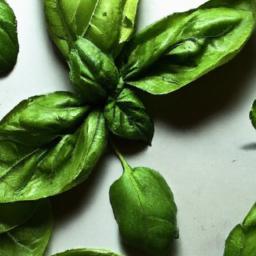Bay Leaves vs. Basil Leaves: Unlocking Distinct Flavors in Your Cooking
If you’ve ever stood in front of your herb rack wondering whether to pick bay leaves or basil for your recipe, you’re not alone. Though their dried forms may appear somewhat similar, these two culinary herbs offer dramatically different tastes and uses in the kitchen.
At How To Cook Gourmet, we understand how confusing herbs can be. Whether you’re seasoning a hearty stew or garnishing a fresh salad, selecting the right leaf can elevate your dish from ordinary to extraordinary.
Flavor Face-Off: Bay Leaves and Basil Leaves
Bay and basil each bring unique characteristics to the table but serve very different purposes. Bay leaves are the subtle background enhancers. Their delicate earthiness and mild bitterness add layers of complexity to slow-cooked meals like soups and braises without overpowering them.
By contrast, basil is vibrant and lively-fresh basil leaves boast a sweet, aromatic, and slightly peppery flavor that instantly enlivens dishes like pasta, pizza, and salads.
| Characteristic | Bay Leaves | Basil Leaves |
|---|---|---|
| Flavor Strength | Subtle, earthy, lightly bitter | Bold, fresh, sweet with peppery undertones |
| Common Culinary Uses | Long-simmered stews, soups, braises | Fresh sauces, salads, quick sautés |
| Preparation Note | Typically removed before serving | Usually consumed fresh or lightly cooked |
It’s essential to note they are not interchangeable – using one in place of the other can result in an unintentional flavor clash or muted dish.
How Bay and Basil Shape Your Dish’s Taste Profile
Understanding how cooking methods interact with these leaves is key to unlocking their full potential:
- Bay Leaves: These thrive in slow-cooked environments. Their flavor compounds gradually infuse a rich, herbal warmth that flourishes over long simmering periods.
- Basil Leaves: Prefer quick or raw applications. Prolonged heat diminishes their bright, peppery notes, so they’re best added at the end of cooking or used fresh.
| Herb | Flavor Profile | Ideal Usage | Cooking Duration |
|---|---|---|---|
| Bay Leaf | Mildly earthy, woody | Stews, soups, braises | Extended simmering |
| Basil Leaf | Bright, sweet, slightly peppery | Salads, pestos, quick sautés | Short cooking or raw |
Before cooking, ask yourself: Do you want a subtle, slow-building layer of flavor or a fresh, bold zing? Your answer will guide the perfect herb choice.
When to Opt for Bay Leaves Over Basil
Choose bay leaves when your recipe benefits from a deeply infused herbal flavor that develops gradually. These leaves shine in dishes like beef stew, vegetable broth, or tomato-based sauces requiring hours of simmering. Their trace floral and woodsy hints deepen complexity without overwhelming.
Basil is the go-to when you want a refreshing burst of flavor that highlights freshness and vibrancy-for instance, in caprese salad, fresh pesto, or quickly prepared pasta sauces. It excels as a finishing ingredient rather than a slow-cooked one.
| Bay Leaves | Basil Leaves |
|---|---|
| Best in extended cooking (soups, stews) | Best fresh or briefly cooked (salads, pesto) |
| Add earthy, subtle notes | Add bright, sweet, peppery flavor |
| Remove before serving | Leaves remain in dish |
Expert Tips: Mastering Bay and Basil in the Kitchen
Maximize the impact of each herb with these professional tips:
- Bay Leaves: Incorporate at the start of cooking. Always use whole leaves and remove them prior to serving to avoid an unpleasant texture and potential choking hazard. For a more potent aroma, gently crush the leaves before adding.
- Basil Leaves: Add fresh basil toward the end of cooking or use it raw to preserve its aromatic oils and vibrant flavor. Avoid overheating to prevent bitter or muted taste.
| Herb | Best Use | Timing | Flavor Highlights |
|---|---|---|---|
| Bay Leaf | Soups, stews, slow braises | At beginning, remove before serving | Earthy, woody, mild bitterness |
| Basil Leaf | Salads, pesto, pasta | Added at end or fresh | Sweet, aromatic, peppery |
Maximize Flavor: Essential Cooking Strategies
Using bay and basil leaves effectively is often a question of timing and preparation:
- For Bay Leaves: Let their essential oils dissolve slowly in the cooking liquid. Breaking the leaf can intensify the flavor but increases the chance of tougher bits remaining. Remove whole leaves to keep the dish pleasant.
- For Basil: Adding at the end retains its crisp, peppery notes and prevents the flavor from fading due to heat. Freshly chopped basil can transform a simple meal into a gourmet experience.
| Leaf | When to Add | Culinary Benefits | Best Pairings |
|---|---|---|---|
| Bay Leaf | Start of cooking | Builds depth, adds warmth | Soups, meats, slow sauces |
| Basil Leaf | End of cooking or raw | Boosts aroma, freshness | Salads, pastas, fresh sauces |
The Chemistry Behind Bay and Basil’s Distinct Flavors
The unique flavors of bay and basil owe much to their chemical constituents. Bay leaves are rich in compounds like eucalyptol and cineole, providing an herbal, pine-like scent with subtle mint notes. Basil’s signature aroma comes from linalool and eugenol, giving it a sweet, spicy, and peppery profile.
It’s important to remember bay leaves are generally not eaten due to their tough, leathery texture, whereas basil leaves are meant to be consumed fresh.
| Leaf | Key Compounds | Typical Flavor | Edibility |
|---|---|---|---|
| Bay Leaf | Eucalyptol, Cineole | Minty, woody, piney | Not usually eaten (removed) |
| Basil Leaf | Linalool, Eugenol | Sweet, spicy, aromatic | Yes, edible |
Common Pitfalls When Handling Bay and Basil
Some frequent errors can hinder your culinary success with these herbs, such as:
- Mixing up bay leaves and basil leaves, expecting similar results.
- Overcooking basil, which causes it to lose its vibrant aroma and taste.
- Forgetting to remove bay leaves before serving, risking a tough texture or choking hazard.
- Trying to substitute one for the other without adapting cooking times and recipes.
| Herb | Proper Use | Common Misuse |
|---|---|---|
| Bay Leaf | Simmered in soups or stews | Eaten whole or added to fresh dishes |
| Basil Leaf | Added fresh or at the end of cooking | Cooked too long, losing flavor |
Recipe Ideas Showcasing Bay and Basil Leaves
Want to see these leaves in action? Here’s how bay leaves and basil each elevate popular dishes:
| Recipe | Bay Leaves Role | Basil Leaves Role |
|---|---|---|
| Rustic Tomato Sauce | Simmered early for depth and subtle woodsy notes | Added fresh at the end for vibrant brightness |
| Slow-Cooked Lamb Stew | Infuses an earthy bouquet over hours | Seldom used, could overpower delicate flavors |
| Caprese Salad | Not used-heavy and overpowering | Fresh leaves torn over mozzarella and tomatoes |
| Vegetable Soup | Adds discreet herbal warmth | Fresh or dried for aromatic punch |
They rarely appear in the same stage of cooking but complement recipes across multiple courses when timed right.
FAQs: Your Bay Leaf and Basil Questions Answered
Q: How can I differentiate bay leaves from basil leaves?
Bay leaves are thick, leathery, and dull green to olive, while basil leaves are soft, delicate, and bright green with a smooth surface.
Q: Do they share similar flavors?
Not at all. Bay leaves impart a subtle, earthy, piney taste while basil offers fresh, sweet, and peppery notes.
Q: When should I use each in my cooking?
Use bay leaves for dishes requiring long cooking times. Basil is best for finishing dishes or fresh applications.
Q: Can I consume bay leaves whole?
No, bay leaves are typically discarded before eating for safety and texture reasons. Basil leaves are edible and delicious.
Q: How long can I keep these herbs?
Dried bay leaves store well for up to a year or more in airtight containers. Fresh basil is perishable, lasting just a few days refrigerated.
Q: Are these herbs beneficial nutritionally?
Yes. Bay leaves contain antioxidants and may aid digestion, while basil is rich in vitamins and has anti-inflammatory properties.
Q: Can bay and basil be used together?
Absolutely! They often complement each other – bay leaves early in cooking, basil added at the end.
Final Thoughts: Harnessing the Power of Bay and Basil in Your Kitchen
Bay leaves and basil leaves are indispensable yet play contrasting culinary roles. Bay leaves contribute a slow-releasing, earthy complexity ideal for long-cooked dishes, while basil bursts with fresh, sweet vibrancy best utilized at the last minute or raw.
By understanding these differences and employing precise timing, you can unlock the true potential of both herbs in your cooking. Whether you favor the subtle depth of bay leaves or the lively aroma of basil, both can transform your meals into extraordinary experiences.
Next time you reach for a leafy herb, know exactly what flavor journey you’re about to embark on. Ready to explore these delightful flavors in your next dish?




